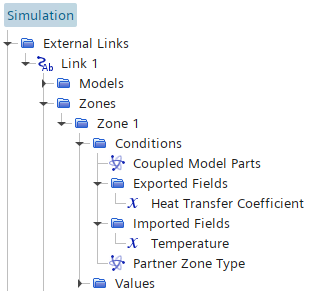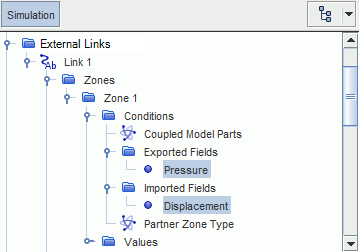Specifying Exported and Imported Fields
For each co-simulation zone, specify the fields that are exchanged between Abaqus and Simcenter STAR-CCM+ during the co-simulation. You specify the exchanged fields using predefined field specifications, that are suitable for common Fluid-Structure Interaction (FSI) and Conjugate Heat Transfer (CHT) applications. Thermal and mechanical exchange can coexist in the same co-simulation.
The field functions that you specify for import/export in Simcenter STAR-CCM+ must match with the exported and imported field types that you set in the Abaqus input file. Fields that are set for export in Abaqus must be set for import in Simcenter STAR-CCM+. Likewise, fields that are set for export in Simcenter STAR-CCM+ must be set for import in Abaqus. See Specifying Co-Simulation Settings in Abaqus.
In CHT co-simulations, Simcenter STAR-CCM+ solves for the heat flux at the coupled boundaries, whereas Abaqus solves for temperature. To specify thermal exchange:
- Activate an Energy model in the fluid continuum.
- Expand the relevant node.
-
Right-click the Exported Fields node, Add
Thermal Field and choose the desired field.
Depending on the version of Abaqus, you can export one of the following combinations of thermal fields:
Simcenter STAR-CCM+ Thermal Field Abaqus Field Type Abaqus Version Heat Flux CFL all versions Heat Transfer Coefficient with Reference Temperature FILM all versions -
To specify the Reference Temperature
Field Function for export:

You can customize the export settings of each exported field node by modifying the node properties. For more information, see [Exported Field] Properties.
- Expand the relevant node.
-
Right-click the
Exported Fields node, select
Add Mechanical Field and choose the desired field.
Simcenter STAR-CCM+ can export Pressure, Wall Shear Stress, or both. As Abaqus applies the fluid loads as a traction profile, Simcenter STAR-CCM+ exports the traction profile as a scalar or a vector quantity depending on which Traction Export Option is selected.
- Select and select the solver that is being used in the Abaqus input file.
-
Right-click the
Imported Fields node and select
.

- To morph the fluid boundary, assign morphing motion to the fluid region. For instructions, see Setting Up Morphing Motion and Solver.
-
You can customize the export settings of each exported field node by modifying the node properties.
For more information, see [Exported Field] Properties.
-
Select the
node and adjust the loading conditions as appropriate.
For more information, see Exported Traction Field Controls.
-
Select the relevant
node and set
Field Treatment to one of the following:
- Managed—with this setting, Simcenter STAR-CCM+ automatically applies imported predefined fields to the coupled boundaries, setting the relevant boundary conditions (see Field Treatment).
- Unmanaged—with this setting, you specify all boundary conditions manually. This approach allows you to set boundary conditions using user-defined field functions or reports that are based on the imported data. For example, if you wish to restrict the imported values to a specific range, you can create a field function that removes field values above or below a certain threshold. If you wish to use the maximum value from an imported field across a whole boundary, you can create a maximum value report. In these cases, you apply the user-defined field function or report to the boundary instead of applying the imported fields directly.
- Imported field: Simcenter STAR-CCM+ initializes the field based on the initial conditions in the associated physics continuum. When initial conditions are not available, you manually initialize the imported field to a constant value.
- Exported field: you manually initialize the imported field to a constant value.
To initialize a field manually:
-
Select the relevant
or
node.
When the field requires manual initialization, Simcenter STAR-CCM+ automatically sets the Initialization Method to User-defined Initialization Value. For cases where the field is initialized automatically, Simcenter STAR-CCM+ sets the Initialization Method to the appropriate option and no input is required.
-
Select the relevant
or
[Import: Field Name] node and specify the constant initialization value.
For more information on all the properties available to imported and exported fields, see Exchanged Fields Reference.
| Note | If you activate the Write Abaqus Keywords option, Simcenter STAR-CCM+ automatically writes the fields definition keywords in the Abaqus input file, according to the import/export conditions specified for the co-simulation zones. If you do not activate the Write Abaqus Keywords option, also specify the imported/exported fields in the Abaqus input file. For more details, see Specifying Co-Simulation Settings in Abaqus. |